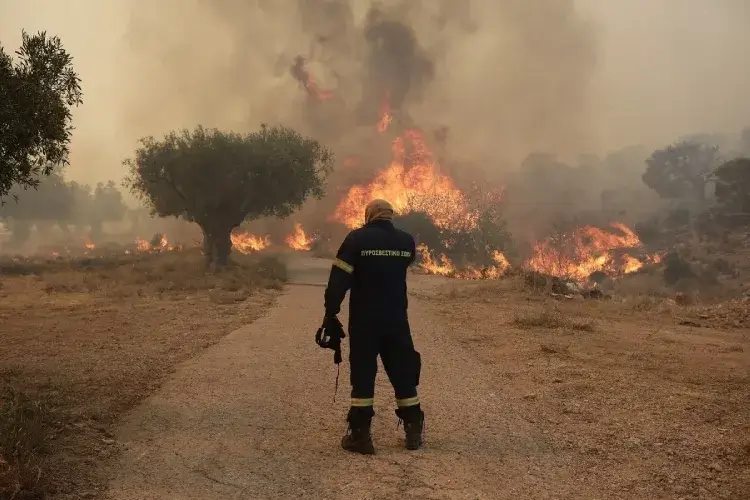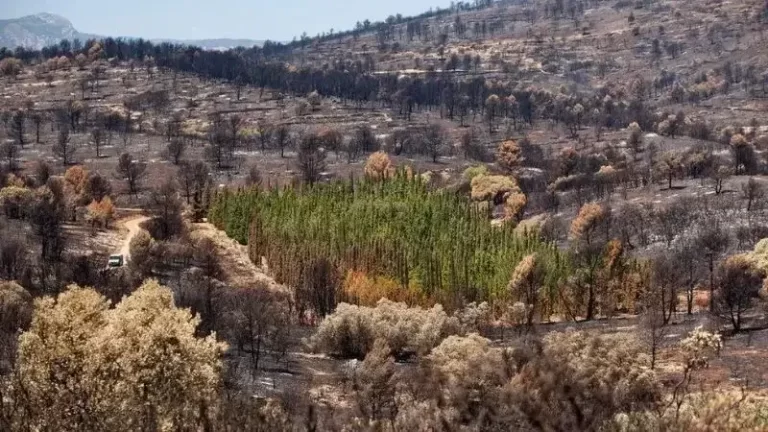Every summer, mainly Mediterranean countries are confronted with devastating fires.
The very hot and dry climate, with strong winds that prevail during the summer periods, but also the increase in global warming due to climate change, make Greece one of these countries.
Unfortunately, apart from the natural causes, there is also the heinous phenomena of arson, which, according to the WWF, together with the human error factor, account for 90% of forest fires.
In recent years, fire phenomena have taken on dramatic proportions, both in the natural world and in human life. Catastrophic fires such as the summer of 2007 in the Peloponnese, but also the deadly Eye of 2021. In fact, 2021 was considered a record year at the time, as 1,301,239 hectares burned in our country,9 as many as had burned in total in the previous 8 years (2013-2020). It did not take long, of course, for this negative record to be surpassed, since in 2023, 962,016 hectares were burnt in Evros and 165,721 hectares in Rhodes alone (a total of 1,127,737 hectares).
From the above, it is clear that prevention is considered necessary by everyone, so that no more human and animal lives are lost, but also the few remaining green lungs.
In addition to the responsibilities of the state, we ourselves can also take certain preventive measures with regard to our green spaces.
One of the most important steps is the selection of trees and plants that are resistant to fire, so-called passive fire retardants. In this article we will specifically deal with trees that offer protection against fire. It is important to note that no tree is flameless/fireproof.
However, many species do offer fire protection as they have the ability to burn slowly, thus limiting the spread of fire. There are many factors that make a tree fire resistant such as its moisture content, its structure, its age and the substances it may contain, such as essential oils, volatile substances and terpenes.
More specifically, characteristics that confer resistance to the spread of a fire are:
- High moisture content in plant parts, such as in succulents that store high amounts of water in their tissues.
- The compact structure, compared to the open structure. A cypress, for example, is more sluggish than an open pine tree.
- The short age, as young plants hold more water than old ones, while at the same time bearing fewer dead stems and leaves.
- The absence of flammable substances that certain trees have, such as pine resin and eucalyptus essential oils. The latter manages to fly its bark over huge distances of up to 10 km, according to forester Dr Gavriil Xanthopoulos.
Let’s see 20 typical examples of fire resistant trees that thrive in the Mediterranean climate of Greece and other countries with similar weather conditions and certainly in areas characterized by high fire risk it is imperative to have them.
2. Viburnum
3. Carob Tree (Ceratonia siliqua)
4. Judas Tree (Cercis siliquastrum)
6. Fig opuntia
7. Liquidambar
9. Black cherry plum or Ornamental plum (Prunus)
10. Strawberry Tree (Arbutus unedo), which even after a fire it sprouts strongly.
11. Magnolia
12. Tuya (Thuja)
13. Yucca
14. Cottonwood or Poplar Tree (Populus)
15. Elm Tree (Ulmus)
16. Black-locust (Robinia pseudoacacia)
17. Linden Trees (Tilia)
18. White Mulberry Tree (Morus alba)
19. Loquat Tree (Eriobotrya japonica)

Along with the installation of fire-resistant trees, another effective protection measure is the creation of firebreaks with materials such as gravel, brick, pebbles and stone, while avoiding wood. Of course, we do not forget to clean up our garden so that the fire will not find something to burn, such as dead grasses and branches, in case it breaks out.
But what do we do in terms of pruning our trees in case a fire breaks out? First, we observe the condition of our tree.
- If it is partially burnt, do not prune it immediately, but wait until it has sprouted and then prune it later.
- If there is a total burn, then pruning must be done immediately, because there is a high risk of falling, since the roots are no longer dead and cannot be supported.
Fact!
The first example of a flammable tree that comes to everyone’s mind and unfortunately exists in a very large area in Greek forests, is of course the pine tree. The Aleppo pine or Pinus halepensis, as it’s Latin name is, is one of the most flammable wood species. At the same time, this tree bears the resin substance, the famous tar, and its fruit, the pine cone, when it comes into contact with fire, can be thrown over enormous distances (as is the case with eucalyptus). But let’s look at a brief history of the pine tree.
The Ancient Greeks created firebreaks with trees such as cypresses, carob trees, oaks and sycamores. These species are considered ‘fire retardant’ because their roots reach a great depth, holding large amounts of water. It was customary in cemeteries located in remote areas to plant cypress trees in dense clumps around the perimeter, in order to create a kind of natural escape route.
Pine trees were later brought in by the Romans, with the aim of setting fire to them whenever the inhabitants of the area rebelled, leading to the burning of entire settlements.


